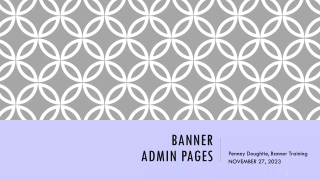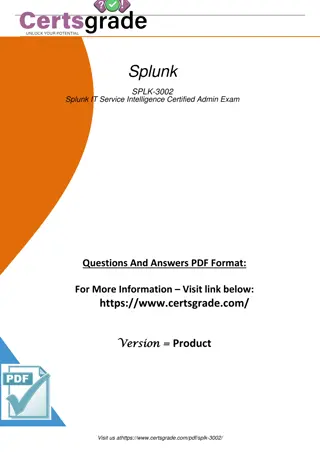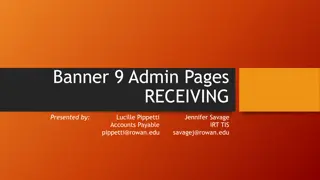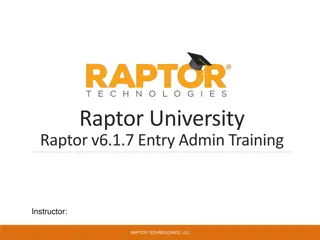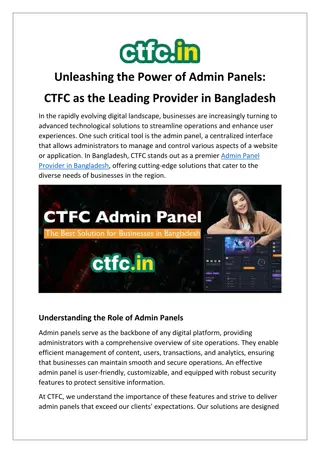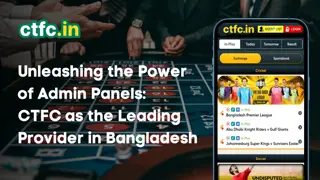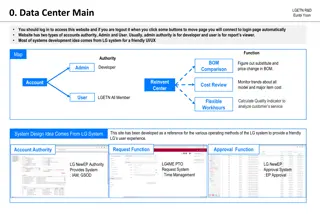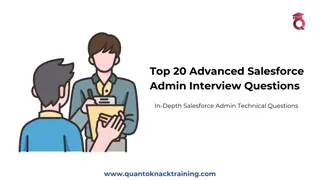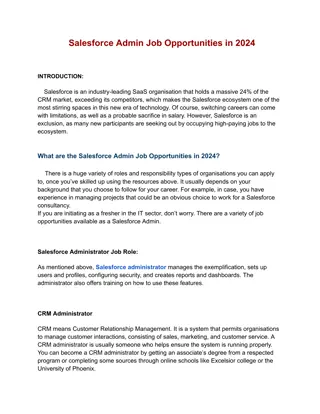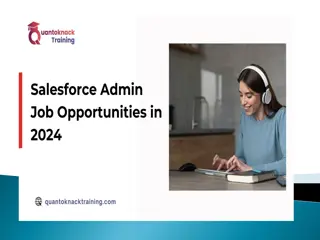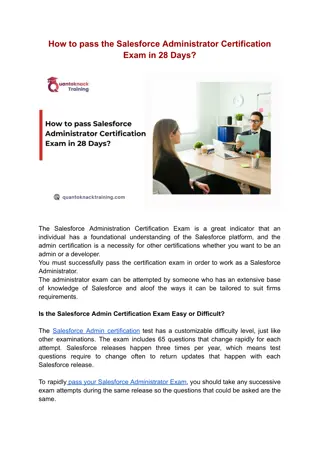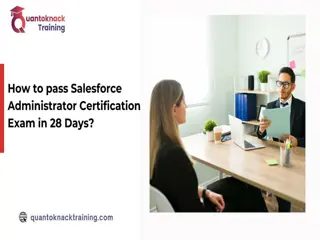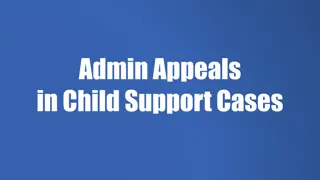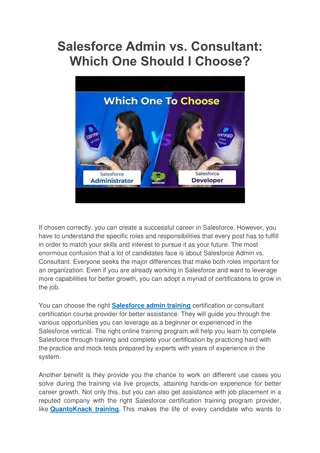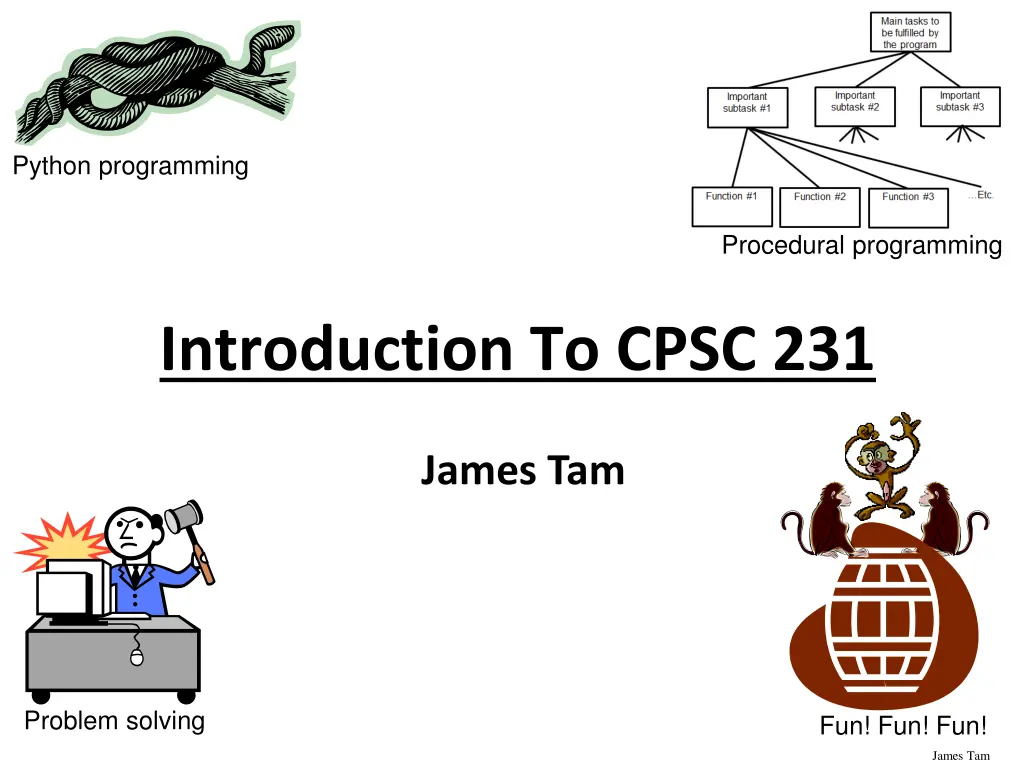
Effective Utilization of Course Resources for CPSC 231 with James Tam
Enhance your learning experience in CPSC 231 with James Tam by effectively using the course resources provided. Stay engaged, catch up on missed information, and take responsibility for your learning. Get tips on how to make the most of the course resources to succeed in your studies.
Download Presentation

Please find below an Image/Link to download the presentation.
The content on the website is provided AS IS for your information and personal use only. It may not be sold, licensed, or shared on other websites without obtaining consent from the author. If you encounter any issues during the download, it is possible that the publisher has removed the file from their server.
You are allowed to download the files provided on this website for personal or commercial use, subject to the condition that they are used lawfully. All files are the property of their respective owners.
The content on the website is provided AS IS for your information and personal use only. It may not be sold, licensed, or shared on other websites without obtaining consent from the author.
E N D
Presentation Transcript
Python programming Procedural programming Introduction To CPSC 231 James Tam Problem solving Fun! Fun! Fun! James Tam
Administrative (James Tam) Contact Information - Office: ICT 707 - Email: tam@ucalgary.ca - Make sure you specify the course name and number in the subject line of the email CPSC 231 Office hours - Office hours: Monday & Tuesday 14:00 14:50 - Appointments possible at other days/times (subject to availability). - Dropping by outside of office hours without prior notice is hit and miss ICT 7th Yes No E My Office x James Tam
Course Resources Required resources: - Course website: http://pages.cpsc.ucalgary.ca/~tamj/2018/231F/index.html (You must get the notes off the course webpage before lecture) Recommended but not required: - "Starting Out with Python"(Gaddis T.) Addison-Wesley. 4th edition new in the campus bookstore 3rdedition can be purchased in the previously enjoyed version - Alternatively you can access any book licensed by the university ( for free ) on the library web site: - (One of many books available) Visual QuickStart guide http://proquest.safaribooksonline.com.ezproxy.lib.ucalgary.ca/ James Tam
How To Use The Course Resources They are provided to support and supplement this class. -The notes outline the topics to be covered -At a minimum look through the notes to see the important topics. -However the notes are just an outline and just looking at them without coming to class isn t sufficient to do well -You will get additional details (e.g., explanations) during lecture time Take notes! If you miss a lecture then get a copy of the in-class notes from another student (who takes detailed notes) James Tam
+ Your Engagement Level ---> Your Learning Learning Computer program Computer programs James Tam
How To Use The Course Resources (2) What you are responsible for: -Keeping up with the content in class which includes the topics covered but also announcements or assignment information whether you were present in the class or not. -If you are absent, then you are responsible for getting the information from the other students in class. Make sure your UC registered email is correct and one you actually read (some course announcements will be sent to these emails) -(I won t be able to repeat the lecture content if you are absent there s just too many of you to make it practical and recall to get the most out of the class you need to be actively engaged) However, after you ve caught up by talking with a classmate: -Ask for help if you need it -There are no dumb questions - except for waiting until the exam James Tam
Tams House Rules I will endeavor to keep the lecture within the prescribed time boundaries You won t pack up and end before time is up James Tam
Tams House Rules No recordings/captures without permission during class please (Recall that learning tends to increase with additional levels of engagement). James Tam
Yes: This Stuff Will Be On The Exam The administrative notes contains important information e.g. how your grades are calculated, course policies etc. To encourage students to pay attention to details (and to reward those who do so): -Some of your midterm multiple questions will come from this section. -You may see a question or two from this section on the final exam as well. James Tam
Evaluation Components Four mini assignments (2/100 of term grade) Five full assignments (28/100 of term grade) Two examinations (60/100 of term grade) James Tam
Assignments You will create a working and executable computer program. Use a text editor (similar to a word processor minus the fancy formatting capabilities) to create it and you will electronically submit the text file (to D2L) for marking. Although you may be given some time in tutorial to work on your assignments (during the open tutorial ) mostly you will complete your work on your own time. -Don t underestimate the time/effort required. -Creating a good working program is harder than it may first appear. Assignments will be marked by the tutorial instructor. -He/she is the first person to go to if you want to determine your grade or have questions about grading. James Tam
Assignments (2) Test your programs using the Linux lab computers (203 lab rooms) running Python 3.x (not 2.x) -If your program doesn t work under these conditions then it will not be marked. Collaboration: -Each student must work on his/her own assignment (no group work is allowed for this class) -Each student must individually submit an assignment -Students must not see each other s assignment code -Additional details will be provided later during the semester You will electronically submit the file which contains your solution to the assignment via D2L: -http://d2l.ucalgary.ca/ -(Find the appropriate course name/number and lecture section) James Tam
Submitting Assignments Bottom line: it is each student s responsibility to make sure that the correct version of the program was submitted on time. -Alternate submission mechanisms e.g., email, uploads to cloud-based systems such as Google drive, time-stamps, TA memories cannot be used as alternatives if you have not properly submitted into D2L -Only files submitted into D2L by the due date is what will be marked Late assignments will not be accepted. If you are ill then medical documentation is required. -Contact your course instructor and not your tutorial instructor to get permission for a late submission James Tam
JTs Helpful Hint: Electronically Submitting Work Bad things sometimes happen! -A virus, hardware failure, you screwed up the submission. Rules of thumb for assignment submissions: -Do it early! (Get familiar with the system) -Do it often! (If somehow real disaster strikes and you lose everything at least you will have a partially completed version that your TA can mark). -Check your work. Don t assume that everything was submitted OK. Don t just check file names but at least take a look at the actual file contents (not only to check that the file wasn t corrupted but also that you submitted the correct version). Assignment 0 A0 : An exercise in tutorial where you practice submitting and checking your work Not directly graded but still important to complete James Tam
How To Verify Submissions In DropBox There is a help link provided with each assignment description. Teaching Assistants will cover in conjunction with Assignment zero. -Not graded but important practice Resource file - http://pages.cpsc.ucalgary.ca/~tamj/resources/Verifying_D2L_Submissions.pdf James Tam
Backing Up And Submitting Your Work Bottom line: it is up to you to make sure things are done correctly and on time. If you have questions beforehand then do ask (make sure you ask your questions early enough so you can receive an answer before the due time). But don t wait until after the due date (it s too late). -If your work isn t in D2L before the due date then you will be awarded no credit. James Tam
Mini Assignments There will be four mini assignments worth 0.5/100 of the term grade for a total of 2/100 of term grade. The focus is learning how to apply the technical concepts (e.g., branches, functions, loops etc.) by writing a small and relatively simple program. Marking will focus on functionality : getting the program to work Although you shouldn t ignore other things such as style and documentation these things won t be graded for the mini- assignments James Tam
Full Assignments Similar to the mini assignments you will write a computer program -The programs will be larger and more challenging than the mini- assignments (require a tough problem to be solved). Marking will not only be based on the functionality of your program but other criteria such as programming style and documentation (additional details will be provided during the semester as each assignment is released). Total weight of the full assignments 28/100 of term grade -Assignment 1: worth 2/100 (introduction to UNIX and writing programs) -Assignment 2: worth 5/100 (introduction to simple programming concepts) -Assignment 3: worth 5/100 (moderately challenging) -Assignment 4: worth 8/100 (quite challenging) -Assignment 5: worth 8/100 (quite challenging but in a different way than the previous assignment) James Tam
Mini And Full Assignments The mini-assignments will tie into and help you start early on the tougher full assignments Full Assignment A1: Introduction to UNIX and writing Python programs A2: Getting programs to automatically repeat and allow for alternatives (looping and branching) A3: Decomposing a program into functions A4: Problem solving, lists, file input and output A5: Classes and objects Mini-Assignment Mini-A2: branching and looping Mini-A3: writing a program that includes functions Mini-A4: Lists Mini-A5: Defining a class and working with objects James Tam
Examinations There will be two examinations: midterm and final exam. Midterm exam -Proportion of the term grade: 30/100 -In class midterm Friday March 2 Final exam (again for multi-section: common to all lectures, out of class) -Proportion of the term grade: 40/100 -Date/time/location determined by the Office the Registrar. -You can find information about your final exams online via the university PeopleSoft portal. Both exams will completed on paper (not in front of a computer). You must pass the weighted average of the exam component to be awarded a grade of C- or higher in the class. James Tam
Examinations (2) Information about the examinations will be available on the main grid before the respective test: -Under the main index: Main grid: Course topics, lecture notes, assignment descriptions, exam information James Tam
Examination Content Multiple choice questions: -Partial program traces e.g., what s the program output -Basic program structure e.g., find the errors, which function or operator is needed for a particular mathematical operation -More examples and details coming during the semester Written questions: -Write a small/partial computer program. -Trace the execution of a computer program e.g., what is the output . -Conceptual (lower weight for this type of question) e.g., definition of a technical term. -Likely there will be a smaller proportion of written questions on the midterm vs. the final. I will be grading the exams. -(I ll do the best I can to get them done in a timely fashion but remember there s a fair number of you in the class). James Tam
Examination Content (2) More sample exam type questions will be provided during the semester. -Sometimes on the fly in lecture so pay attention to these and take notes. James Tam
Grades For Each Component The official grading mechanism for this (and most) universities is a letter grade/grade point e.g. A/4.0, A-/3.7 etc. Term grades must be stated as a letter grade. Component grades (assignment, exam etc.) can either be a letter grade or a raw score (e.g. percentage) For this class -each major component will be awarded a grade point (and not a percentage) e.g. the 2.0 GPA and not 65% will be used to calculate your term grade. -and this is the value used to determine the term grade. James Tam
Grading: Course Components Each course component will have a grading key Sample from a past assignment (different course) A student who completes only Features #5 7 will be awarded an assignment grade point of 0.2 + 0.2 + 1.0 = 1.4 (just over a D+ grade) Examinations will include a lookup table (raw percentage score to grade point). Sample from another course. James Tam
Why Grade Points? It s the official university grading system -Alternatives are possible but require faculty level approval Approval of anything other than a grade point system requires predetermined cutoffs at the start of the term e.g., >= 90% equals A etc. -Doesn t allow for consideration that individual components may be more challenging than others (lower cutoffs) Grade points are more lenient for grades on the lower-middle end of the scale -Grade points: Getting an A /4.0 on the assignment component worth 30% of the term grade yields a minimum term grade of 1.2 (4.0 * 0.3) which equates to a term grade of D (possibly higher) -Percentages: Getting an A may roughly work out to 90% or higher (depending on the scale) which works out to a minimum term percent of 27% = 90% score * 30% weight almost certainly an F for the term grade. James Tam
Grade Points Are Letter Grades Not Percentages For examinations the mapping between a raw score and a grade point occurs one way (raw score mapped to grade point) -Example (purely for illustration purposes) 65 69% = C/2.0, 70 74% = C+/2.3 -But grade points don t correlate back to percentages e.g. I was awarded a 66% on midterm and then I see this is a 2.0 GPA (out of 4.0) Does this mean that my percentage went from a 66% to a 50%!!!??? No. A C/2.0 does not mean that 50% was awarded as a course grade. To put this in perspective a passing grade point in this university is a 1.0/D in a course. If a grade point mapped back to a percentage this would mean that anyone getting a 25% or higher would pass any course here. The mapping of the midterm to grade point will be posted sometime after the midterm grades have been released. The mapping of the final exam to grade point will be posted sometime after the final exam grades have been released. James Tam
Estimating Your Overall Term Grade Point To determine your weighted term grade point simply multiply each grade point by the weight of each component. -Percentages won t be used to determine the term grade point/letter Sum the weighted grade points to determine the term grade. Simple and short example (not exactly the same as this term but it should be enough to give you an idea of how to do the specific calculations required this semester): Assignments: weight = 30/100, example score = A Midterm: weight = 30/100, example score = B+ Final: weight = 40/100, example score = C- Weighted assignments: 0.3 * 4.0 = 1.2 Weighted midterm: 0.3 * 3.3 = 0.99 Weighted final: 0.4 * 1.7 = 0.68 Total term grade point = 1.2 + 0.99 + 0.68 = 2.87 (In this case the term letter is B-) James Tam
Estimating Your Overall Term Grade Point (2) Use the spreadsheet on the course web page to estimate your term letter grade: -http://pages.cpsc.ucalgary.ca/~tamj/2018/203W/grade_calculator.xlsx The grade point to letter grade mapping employs the official university cutoffs: -http://www.ucalgary.ca/pubs/calendar/current/f-2.html -(I may employ a more lenient set of cutoffs at the end of term but the official cutoffs will provide you with a worse case estimate of your grade). -Also an A+ doesn t have a specified letter grade that is different from an A for term letter grades. I ll likely extrapolate the pattern e.g. C+ = 2.3, B+ = 3.3 so an A+ will be higher than a 4.0 and a bit lower than 4.3 (because not all course components allow for an A+ to be awarded) 1 Note: to keep things simple the formula in the spreadsheet does not check if the exam component was passed or not (you can do the check manually or add it in yourself) James Tam
Contrast The CutOffs Official UC cutoffs The Tam cutoffs 4 4 3.7 3.3 3.0 2.7 2.3 2.0 1.7 1.3 1.0 0 The cutoffs in the spreadsheet are significantly more lenient (almost everyone gets a big break e.g. instead of 3.7 for an A- it s 3.5 (midpoint between A-/3.7 and B+/3.3 is the higher letter grade) Do not expect a further rounding up at the end of the term e.g. 3.4999999999999999999999999999999999999999999999999 is soooooooooooooooooooooooooooooooooooooooooooooooo close to 3.5 can t you get an A- No or using an Internet emphasis NOOOOOOOOOOOOOOOOOOOOOOOOOOOOOOOOOOOOOOOOOOOOOOOOOOOOOOOOOOOOO OOOOOOOOOOOOOOOOOOOOOOOOOOOOOOOOOOOO!!!!!!!!!!!!!!!!!!!!!!!!!!!!!!!!!!!!!!!!!!!!!!!!!!!!!!!!!!!!!!!!!!!!!!!!! !!!!!!!!!!!!!!!!!!!!!!!!!!!!!!!!!!!!!!!!!!!!!!!!!!!! James Tam
Common Computer Skills Assumed You know what a computer is! You ve used a computer in some form (e.g., turn on, turn off, open a file, played a game, gone online etc.) You have experience using common applications (specifically email, web browsers, text editing using a word processor). James Tam
What This Course (CPSC 231) Is About Writing/creating computer programs. But it is not assumed that you have prior knowledge of Computer Science (or even experience writing programs) It can be a lot of work. Satisfaction coming from solving that tough algorithm! Late night coding - The course can be completed by students with a normal course load (many already have gotten through it!) - But be cautious if you already have many other commitments Wav file from Tam James Tam
Actual Practice: Common Interview Questions Besides looking at degrees granted and grades received, some tech companies (e.g., Google) may ask you questions that appear non-technical: -You re asked to solve puzzles during the interview. There is a relationship between skill at solving puzzles ( problem solving ) and success in a (technically oriented) industry. -You will develop these skills writing programs for this class. Example list of questions http://www.businessinsider.com/15-google-interview-questions-that-will-make-you-feel-stupid-2009-11 James Tam
Course Goals Know the basic structure of a computer program (rules for laying out a program and how the basic constructs such as repetition and branching work) -If you don t know and understand these concepts then your program won t work at all and you can t proceed to the next goals. Develop basic problem solving and analysis skills. -As mentioned this is a skill that you will need to develop for the real world Learn good design principles. -For example you may know how to get a program to run across the Internet but you may not know how to write a fun game that people will want to play on Facebook . - This *%$#! App really sucks! James Tam
How To Succeed Successful people James Tam
How To Succeed In This Course 1. Practice things yourself (not by getting the answer from someone/someplace else). Providing solutions to assignments may be popular among students but useless for learning What s needed is for me to teach you the skills to solve any reasonable size problem - How Computer Science works: You get better by doing things for yourself (this is a hands-on field of study and work). You have to do it yourself Similar to getting fit: you can t just watch James Tam
How To Succeed In This Course (2) - Write lots programs. At the very least attempt every assignment. Try to do some additional practice work (some examples will be given in class, some practice assignments will be available on the course web page). Write lots of little test programs to help you understand and apply the concepts being taught. - Trace lots of code (computer programs) Involves reading through programs that other people have written, and executing it by hand in order to understand how and why it works This is an essential skill. Relying on just running the program and observing the results won t always work (errors?) James Tam
How To Succeed In This Course (3) 2. Make sure that you keep up with the material - Many of the concepts taught later depend upon your knowledge of earlier concepts. - Don t let yourself fall behind! - At least attempt all assignments! Rule of thumb: don t fall behind more than 1 week : Problem decomposition Loops/repetition Decisions/branching Introduction to programming James Tam
How To Succeed In This Course (4) If you find concepts unclear trying to research the answer on your own can be beneficial (because this is a hands on field). -Read alternate explanations of the concepts covered in class in the text book (or other textbooks: remember that electronic books accessible through the library-Safari are free ). -Looking at online resources: Remember academic resources online just like other online information may not always be a good source. Start with more reputable sources http://proquest.safaribooksonline.com.ezproxy.lib.ucalgary.ca/ www.python.org Addendum to the previous point #2 and a point raised earlier ask questions . -If you are still unclear on concepts then make sure that you ask for help. -Don t wait too long (more than a few days) to do this because latter concepts may strongly depend on your understanding of earlier concepts.. James Tam
How To Succeed In This Course (5) 3. Look at the material before coming to lecture so you have a rough idea of what I will be talking about that day: a) Read the slides b) Look through the textbook(s) When we get to more complicated programs that appear to jump around in how they execute ( section: problem decomposition/functions ) just having an idea of the scope and components of the program beforehand can be useful when I cover it in class. James Tam
How To Succeed In This Course (6) 4. Start working on things as early as possible: - Don't cram the material just before the exam, instead you should be studying the concepts as you learn them throughout the term. - It s important to work through and understand concepts *before* you start (full) assignments. - If you try to learn a new concept and work out a solution for the assignment at the same time then you may become overwhelmed. - Don t start assignments the night (or day!) that they are due, they may take more time than you first thought (start as soon as possible). - Some assignments may require the application of multiple concepts, not all the concepts have to be completely covered before you start working on an assignment. Start working based on what s currently been covered (this will teach you how to decompose a program and work on it a part at a time). James Tam
How To Succeed In This Course: A Summary 1. Practice things yourself 2. Make sure that you keep up with the material 3. Look at the material before coming to lecture 4. Start working on things early James Tam
Computer Science: Help And Teaching Tutorials Help tutorials ( Continuous Tutorial/CT ): -Attendance is not required (no official registration) -Q & A session: it will be used as an additional place where you can get help. -Located near the technical Help Desk Math Sciences CPSC tech help CT for CPSC 231 -The CT schedule will be posted early in the semester. James Tam
Computer Science: Help And Teaching Tutorials Teaching tutorials: MS 160 MS176 -They will be conducted by the Teaching Assistants (TA). -A mandatory component of the course (registration in a specific section is required). -Review of concepts covered in lecture (especially the more challenging ones). -Discussion of assignment requirements. -Assignment and exam feedback/return after grading is complete. James Tam
Computer Science: Labs And Tutorials (Reminder: 2) (Teaching tutorial information continued): -Practice exercises. - Open tutorials will sometimes be held (extra CT/help time where TA s will be available to help students). More information about tutorials and labs is available on the course web site: -http://pages.cpsc.ucalgary.ca/~tamj/2018/231/index.html#Tutorial_information James Tam

